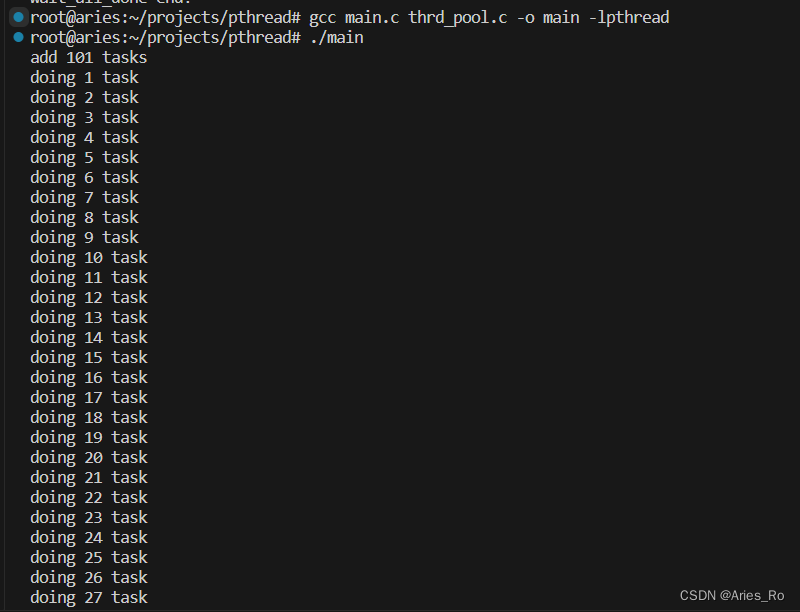简介
本线程池采用C语言实现
线程池的场景:
当某些任务特别耗时(例如大量的IO读写操作),严重影响线程其他的任务的执行,可以使用线程池
线程池的一般特点:
线程池通常是一个生产者-消费者模型
生产者线程用于发布任务,任务通常保存在任务队列中
线程池作为消费者,用于取出任务,执行任务
线程池中线程数量的选择:
有一个经验公式: 线程数量 =(io等待时间+cpu运算时间)*核心数/cpu运算时间
因此可以根据经验公式得出下面两种场景的线程数量:
- cpu密集任务:线程数量=核心数(即上面的公式假设cpu运算时间>>io等待时间)
- io密集任务:线程数量=2*n+2
手写线程池
线程池代码结构:
- thread_pool_create:创建线程池所需要的资源,包含不限于任务队列,子线程的创建。
- thread_pool_post:用于任务的发布,将执行任务存在任务队列中。
- thread_pool_destroy:用于线程池的退出,以及资源的销毁。
- wait_all_done:join线程池所有子线程,等待回收子线程。
- thread_worker:用于任务执行。
主要的核心点集中在thread_pool_post和thread_worker两个函数中,这两个函数也构成了生产者-消费者模型。本文采用队列+互斥锁+条件变量实现。
线程池结构体分析
由于C语言不像C++可以用类封装函数,因此线程池会使用结构体来封装一些变量或者函数指针。
task_t
封装任务的入口指针以及参数。
typedef struct task_t { handler_pt func; void * arg; } task_t;
task_queue_t
封装任务队列,为了不频繁移动队列中数据,此处采用头尾索引来标记任务。
typedef struct task_queue_t { uint32_t head; uint32_t tail; uint32_t count; task_t *queue; } task_queue_t;
thread_pool_t
包含互斥锁,条件变量,任务队列等信息
struct thread_pool_t { pthread_mutex_t mutex; pthread_cond_t condition; //条件变量 pthread_t *threads; //线程 task_queue_t task_queue; //任务队列 int closed; //是否关闭线程池执行的标志,为1表示关闭 int started; // 当前正在运行的线程数 int thrd_count; //线程数 int queue_size; //任务队列大小 };
其中closed:表示是否关闭线程池执行的标志,为1表示关闭。在线程的运行函数中,用来判断是否继续循环等待执行任务队列中的任务。
started:表示当前正在运行的线程数。在thread_pool_destroy函数中销毁线程池时,需要等待所有线程停止才行,即started == 0
线程池函数分析
thread_pool_create
创建线程池,初始化一些线程池属性
通过循环pthread_create函数创建子线程。
thread_pool_t *thread_pool_create(int thrd_count, int queue_size) { thread_pool_t *pool; if (thrd_count <= 0 || queue_size <= 0) { return NULL; } pool = (thread_pool_t*) malloc(sizeof(*pool)); if (pool == NULL) { return NULL; } pool->thrd_count = 0; pool->queue_size = queue_size; pool->task_queue.head = 0; pool->task_queue.tail = 0; pool->task_queue.count = 0; pool->started = pool->closed = 0; pool->task_queue.queue = (task_t*)malloc(sizeof(task_t)*queue_size); if (pool->task_queue.queue == NULL) { // TODO: free pool return NULL; } pool->threads = (pthread_t*) malloc(sizeof(pthread_t) * thrd_count); if (pool->threads == NULL) { // TODO: free pool return NULL; } int i = 0; for (; i < thrd_count; i++) { if (pthread_create(&(pool ->threads[i]), NULL, thread_worker, (void*)pool) != 0) { // TODO: free pool return NULL; } pool->thrd_count++; pool->started++; } return pool; }
thread_pool_post
作为生产者,往任务队列里面添加任务
通过pthread_cond_signal通知子唤醒子线程的pthread_cond_wait
int thread_pool_post(thread_pool_t *pool, handler_pt func, void *arg) { if (pool == NULL || func == NULL) { return -1; } task_queue_t *task_queue = &(pool->task_queue); //此处用自旋锁会更节省消耗,因为锁里面的逻辑比较简单 if (pthread_mutex_lock(&(pool->mutex)) != 0) { return -2; } if (pool->closed) { pthread_mutex_unlock(&(pool->mutex)); return -3; } if (task_queue->count == pool->queue_size) { pthread_mutex_unlock(&(pool->mutex)); return -4; } //避免queue数据的变化,采用头尾索引来标识 task_queue->queue[task_queue->tail].func = func; task_queue->queue[task_queue->tail].arg = arg; task_queue->tail = (task_queue->tail + 1) % pool->queue_size; task_queue->count++; //唤醒一个休眠的线程 if (pthread_cond_signal(&(pool->condition)) != 0) { pthread_mutex_unlock(&(pool->mutex)); return -5; } pthread_mutex_unlock(&(pool->mutex)); return 0; }
thread_worker
pthread_cond_wait等待任务的唤醒
作为消费者, (*(task.func))(task.arg);执行任务
static void *thread_worker(void *thrd_pool) { thread_pool_t *pool = (thread_pool_t*)thrd_pool; task_queue_t *que; task_t task; for (;;) { pthread_mutex_lock(&(pool->mutex)); que = &pool->task_queue; while (que->count == 0 && pool->closed == 0) { // 阻塞在 condition,等待任务队列添加任务 pthread_cond_wait(&(pool->condition), &(pool->mutex)); } if (pool->closed == 1 && que->count == 0) break;//没有任务,并且关闭标志打开,即跳出循环 task = que->queue[que->head]; que->head = (que->head + 1) % pool->queue_size; que->count--; pthread_mutex_unlock(&(pool->mutex)); (*(task.func))(task.arg);//执行对应任务函数 } pool->started--;//跳出循环之后,运行线程数需要减1 pthread_mutex_unlock(&(pool->mutex)); pthread_exit(NULL); return NULL; }
thread_pool_destroy
销毁释放线程池,置 pool->closed = 1;
通过pthread_cond_broadcast唤醒线程池所有线程,这个和thread_pool_post里的pthread_cond_signal一样,并且broadcast会通知到所有的线程
int thread_pool_destroy(thread_pool_t *pool) { if (pool == NULL) { return -1; } if (pthread_mutex_lock(&(pool->mutex)) != 0) { return -2; } if (pool->closed) { thread_pool_free(pool); return -3; } pool->closed = 1; //广播形式,通知所有阻塞在condition的线程接触阻塞 if (pthread_cond_broadcast(&(pool->condition)) != 0 || pthread_mutex_unlock(&(pool->mutex)) != 0) { thread_pool_free(pool); return -4; } wait_all_done(pool); thread_pool_free(pool); return 0; }
wait_all_done
将所有线程通过pthread_join回收,所有子线程任务执行完毕,回收线程
int wait_all_done(thread_pool_t *pool) { printf("wait_all_done start!pool->thrd_count:%d\n", pool->thrd_count); int i, ret=0; for (i=0; i < pool->thrd_count; i++) { printf("wait_all_done doing! i:%d\n", i); if (pthread_join(pool->threads[i], NULL) != 0) { ret=1; } } printf("wait_all_done end!\n"); return ret; }
thread_pool_free
释放线程池空间
static void thread_pool_free(thread_pool_t *pool) { if (pool == NULL || pool->started > 0) { return; } if (pool->threads) { free(pool->threads); pool->threads = NULL; pthread_mutex_lock(&(pool->mutex)); pthread_mutex_destroy(&pool->mutex); pthread_cond_destroy(&pool->condition); } if (pool->task_queue.queue) { free(pool->task_queue.queue); pool->task_queue.queue = NULL; } free(pool); }
主函数调用
#include <stdio.h> #include <stdlib.h> #include <pthread.h> #include <unistd.h> #include "thrd_pool.h" int nums = 0; int done = 0; int task_num = 100; pthread_mutex_t lock; void do_task(void *arg) { usleep(10000); pthread_mutex_lock(&lock); done++; printf("doing %d task\n", done); pthread_mutex_unlock(&lock); } int main(int argc, char **argv) { int threads = 8; int queue_size = 256; if (argc == 2) { threads = atoi(argv[1]); if (threads <= 0) { printf("threads number error: %d\n", threads); return 1; } } else if (argc > 2) { threads = atoi(argv[1]); queue_size = atoi(argv[1]); if (threads <= 0 || queue_size <= 0) { printf("threads number or queue size error: %d,%d\n", threads, queue_size); return 1; } } thread_pool_t *pool = thread_pool_create(threads, queue_size); if (pool == NULL) { printf("thread pool create error!\n"); return 1; } while (thread_pool_post(pool, &do_task, NULL) == 0) { pthread_mutex_lock(&lock); nums++; pthread_mutex_unlock(&lock); if (nums > task_num) break; } printf("add %d tasks\n", nums); usleep(1000000);//延时等待所有的作业完成 printf("did %d tasks\n", done); thread_pool_destroy(pool); return 0; }
运行结果
使用指令编译文件:
gcc main.c thrd_pool.c -o main -lpthread
运行执行文件得到运行结果
完整代码下载线程池Linux C语言简单版本



